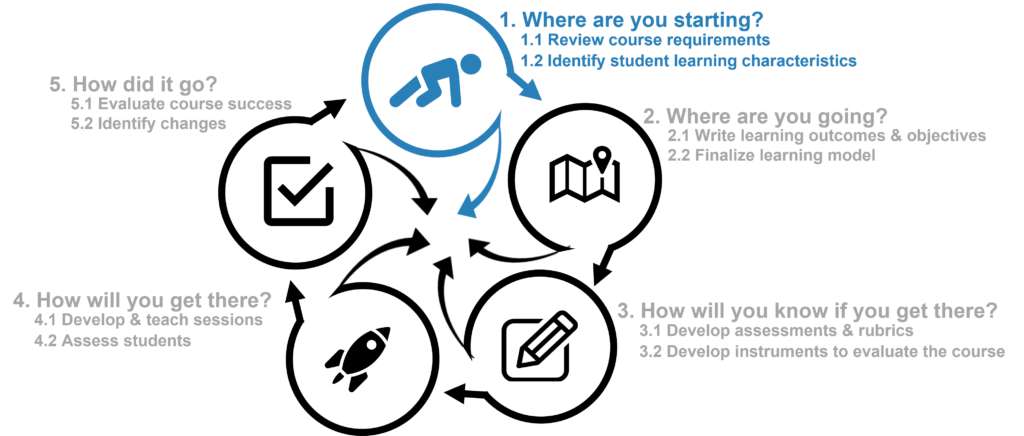Unit W – The IDI Workbook
Step 1: Where Are You Starting?
1.2 Identify Student Learning Characteristics

In this step, you will identify required elements of your course and basic information about your students. You will also review previous evaluations of your courses and teaching to identify any changes you had identified.
This step will help you define what you want your students to be able to accomplish at the end of the course – your learning outcomes.
1.2 Results (What)
- A list of your students’ typical current majors and university year
- Year, age, major, and other characteristics that may impact their learning
- Reflection on how this may impact your course design
1.2 Overview (Why)
Learner characteristics define the ‘typical’ student groups. Some characteristics are easy to identify such as some international students, older than average students, etc. These differences can impact how the students learn. For example, cultural and gender differences may influence student involvement in a class; generational differences may influence reliance on technologies for learning and research; new university students may have a different mindset than seniors on responsibilities of faculty and students for learning, etc.
Differences can be defined many ways including:
- demographic differences (cultural, socioeconomic, racial, age, gender, level of education, etc.)
- abilities and special needs
- motivation to learn subject
- program of study (majors)
For more on inclusion, diversity, and accessibility and how you can support the diversity of students in your class, see B4.
If we are interested in student-centered learning, we must understand our students. This step in the IDI process is to identify the main types of learners you will be teaching. This becomes important as you progress through your redesign when you identify learning outcomes, objectives, and activities that appeal and work with various students.
Understanding some of these differences can help you identify methods that may support student growth not just in learning your subject, but in becoming critical, life-long learners.
1.2 Suggestions/Instructions (How & What If)
Learning Goals
Based upon your reflections on student characteristics, you may decide to add some learning goals. You can use the AAC&U’s Goals of Liberal Education (What Is Liberal Education?, 2022), Fink’s Significant Learning categories (Fink, 2013) and the Angelo & Cross Teaching Goals Inventory (Angelo & Cross, 1993) to help you identify and phrase these.
Steps
- Based on the learner characteristics, identify how important are active learning and cooperative learning (Respects diverse talents and ways of learning (Chickering & Gamson, 1987). (B2, A3)
- Consider how the student characteristics might impact their mental models – epistemological level, mental schemas, margin, and ability to accept threshold concepts, etc.? How might this impact their ability to accept each transformative concept? (A3, A11, C2, A2, A7)
- Review student demographics to identify:
- 1st year students – epistemological considerations. (A7)
- age & culture – potential schema/TCs. (A2)
- experience listening to a lecture.(C6)
- Identify why your students are attending your course (is it a requirement or elective?). This can impact their motivation and personal goals.(A10)
- Ensure that your expectations are aligned with both student characteristics (not expecting too much or too little) and learning outcomes (Chickering & Gamson, 1987). (B2, A8, A9, C2, C5, C10)
- Especially in first-year courses, do not assume students have the prerequisite prior knowledge (Addy et al., 2020). Consider a first-day pre-test and/or pre-req content review. (B3, C2)
- Identify student support departments such as disability services and study centers to identify what they offer students. (A3, B1)
- Based on student level and major, consider which unasked questions you need to include (Why, What, How, What If). (B2)
1.2 Worksheets
Go to: W1.2 Worksheets (Word doc opens in new tab)
1.2 Identify Student Learning Characteristics
Use this form to capture demographic information such as age, gender, residency, year-of-college, and major.
Go to:
Step 1.1
Unit A. Theories
View this page (W1.2 Details) as .pdf (.pdf opens in new tab)
Go to: W1.2 Worksheets (Word doc opens in new tab)
1.2 References
Addy, T. M., Dube, D., & Mitchell, K. A. (2020, August 5). Fostering an Inclusive Classroom. Inside Higher Ed. https://www.insidehighered.com/advice/2020/08/05/small-steps-instructors-can-take-build-more-inclusive-classrooms-opinion
Angelo, T., & Cross, K. P. (1993). Classroom Assessment Techniques: A Handbook for College Teachers (2nd ed.). Jossey-Bass.
Chickering, A. W., & Gamson, Z. F. (1987). Seven Principles for Good Practice in Undergraduate Education. AAHE Bulletin. https://eric.ed.gov/?id=ED282491
Fink, L. D. (2013). Creating Significant Learning Experiences: An Integrated Approach to Designing College Courses (Revised and updated edition). Jossey-Bass.
What Is Liberal Education? (2022, August 1). AAC&U. https://www.aacu.org/trending-topics/what-is-liberal-education
Go to:
Step 1.1
Unit A. Theories
View this page (W1.2 Details) as .pdf (.pdf opens in new tab)
Go to: W1.2 Worksheets (Word doc opens in new tab)
Updated 2024-06
